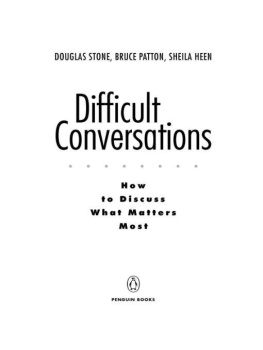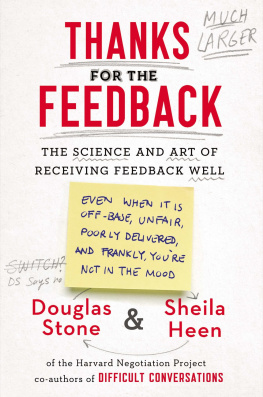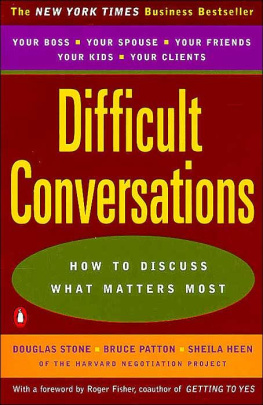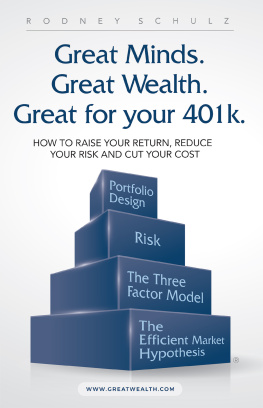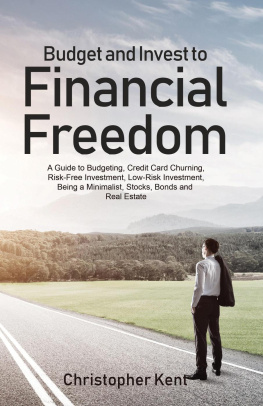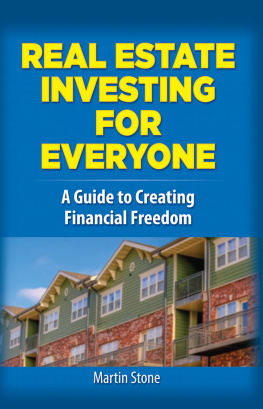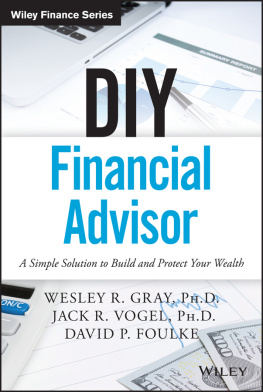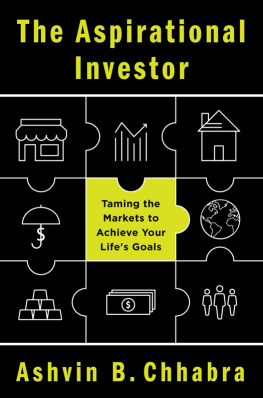All rights reserved.
This book is for Jennifer. Thank you so much for standing by me and encouraging me to tackle this project. Without your support and encouragement, this book might not exist.
Its also for Jeremy and Madison, both of whom have shown an interest in helping others navigate the investment jungle. I hope this book will play a role in guiding you both on the path of financial knowledge.
Finally, this book is for my clients, past, present, and future. You motivate me to keep learning and sharing my knowledge.
Authors note : To protect the identities of people described in these pages, pseudonyms are used throughout.
Introduction
It was the year 2000. The tech bubble was growing fast and tech stocks were increasing rapidly in priceif not in value. The profits were out of this world. It was tempting to believe that they always would be.
Nonetheless, I was determined to stay grounded. As a registered investment advisor, I always seek to hedge against the downside of any investment. Thats simple due diligence. With the prices of tech stocks exploding into the stratosphere, I was looking for a way to hedge against volatility. If they crashed, how would I protect my clients from the worst of the downside?
While I was pondering this question, I heard a sales pitch from some mutual fund wholesalers. I liked their pitch and accepted what they told methat mutual funds were a good way to hedge against market volatility.
Based on the information they gave me, I bought my clients into a range of their products. I had bond funds. I had high yield bond funds. I had corporate bond funds. When the market went down, those funds should have gone up, right? That was why I had them. Unfortunately, that didnt happen. When the tech bubble burst, everything dropped through the floor at the same time. Something was wrong with my strategy.
A Question of Risk
As I reviewed my clients accounts, I realized that the makeup of their portfolios wasnt working. They were exposed to too much market risk. My task as their financial advisor was to eliminate as much risk as possible, so the bursting of the tech bubble was a major wake - up call. One thing was clear: I needed a different approach, a new game plan.
The more I investigated my clients portfolios, the more obvious it became that they all suffered from a similar flaw: as long as markets were doing well, they yielded high levels of profit. When the markets went down, however, these same portfolios were poorly set up to minimize losses. I had been told that mutual funds would perform this role, but reality firmly disabused me of that notion. When the tech wave crashed against the shore, mutual funds had done little or nothing to limit the damage.
At that point, I took a step back. I started questioning the products I was using and did my own thorough research. I educated myself on the true purpose of mutual funds and discovered that in many cases they serve the seller, not the investor. It was an eye - opening realization that has reshaped my whole perspective on financial planning.
Nowadays, when I see other advisors using mutual funds, I suspect they havent done their due diligence. They know that if they add mutual funds to their clients accounts, they receive a commission, and that alone convinces them its the right thing to do. Often, it isnt.
Please dont think that Im against advisors earning money. We work hard for our clients and we deserve to see solid profits. I firmly believe, however, that the financial success of an advisor should never come at the expense of a clients best interests. We should always ask whether a particular product helps our clients achieve their goals. If it doesnt, its not a good choice.
The mutual fund representative Id spoken to assured me that the funds had a great track record. In a market that had shown consistent growth for years, they probably did. What the rep didnt mention was how the same funds performed when the market dropped. He was more interested in telling me how much I could earn when clients used the products. When the tech bubble burst, I found out for myself how they performed in a downturn.
I hold my hands up and admit that I, like most everyone else in my profession, drank the Kool - Aid . In the midst of the tech boom, optimism was high. I believed what I was told, trusting that the mutual funds I purchased would provide sufficient protection against market pain. It was only when the results didnt meet my expectations that I seriously questioned the information I had received.
Naturally, the reps rushed to tell me that I was looking at the situation incorrectly. I might have bought their slick presentations earlier, but now those presentations were belied by reality. Of course, reality is the best indicator of any strategys success. Reality was hitting hard, and I could clearly see that the strategy Id been pursuing wasnt working.
In good times, its easy to be lulled into inattention. We assume that the future will be like the past. If things are good, and have been good for a while, we may conclude that they will always be good. But this can lead to complacency and a loss of focus. Theres a disconnect. The problem with this approach is that when things go bad, were unprepared, were taken by surprise and we panic.
The only way to head off panic is to understand the risks of a course of action. When the tech bubble burst and I saw that hedging against mutual funds wasnt counteracting the losses, I realized how much of the advice I had received in my career was predicated on good times, with little understanding of the risks. That was when I understood how much more there was to learn. The fruits of this learning process are the subject of this book.
Pitfalls of the Retail Investment Model
As an investor, you want to trust that your financial advisor has your best interests at heart. You also want to trust that your advisor has the knowledge to serve those interests. If either of those pieces is missing, youre in trouble!
Over the years, its become increasingly obvious to me that many advisors are constructing portfolios based on a model I call the retail model. Theyre investing like individuals. And just like individuals, theyre vulnerable to the emotional swings and roundabouts of the market.
Early in my career, I followed the retail model and fell into many of the traps in this book. I learned from mentors who showed me how to construct a portfolio based on the principles of that model. When I was unsure which investments to prefer, they guided me to a list of mutual funds recommended by the firm where I was working.
Naturally, I picked from the menu I was given. Navely, I imagined that the funds on that menu were chosen because they offered the best performance. That wasnt necessarily the case. It turned out that many of the recommended funds were the ones offering brokers the highest commission. I wasnt encouraged to ask a lot of questions, and being young and new to the business, I followed the examples set by more senior members of the practice.
I can still remember the first time my belief in the rightness of this approach was dented. A very conservative client of mine sat down with me for a meeting and began to ask pointed questions about his investments. Although this man was heavily invested in treasury bills and government bonds, he also had a portion of his portfolio in mutual funds. My firm was responsible for managing that part of his investments. At the time, the mutual funds werent performing well.


